Home » SWICo Papers (Page 3)
Category Archives: SWICo Papers
Detection Capability of Flux Ropes during the Solar Orbiter Mission
Papers from SWICo members
Telloni, Daniele; D’Amicis, Raffaella; Bruno, Roberto; Carbone, Francesco; Perrone, Denise; Zank, Gary P.; Zhao, Lingling; Nakanotani, Masaru; Adhikari, Laxman
Flux ropes are interplanetary magnetic helical structures that are receiving increasing attention because of their likely role in magnetohydrodynamic (MHD) processes as well as their impact on space weather science. A very promising and powerful approach to address their investigation and characterization is based on wavelet spectrograms of the invariants of the ideal MHD equations.
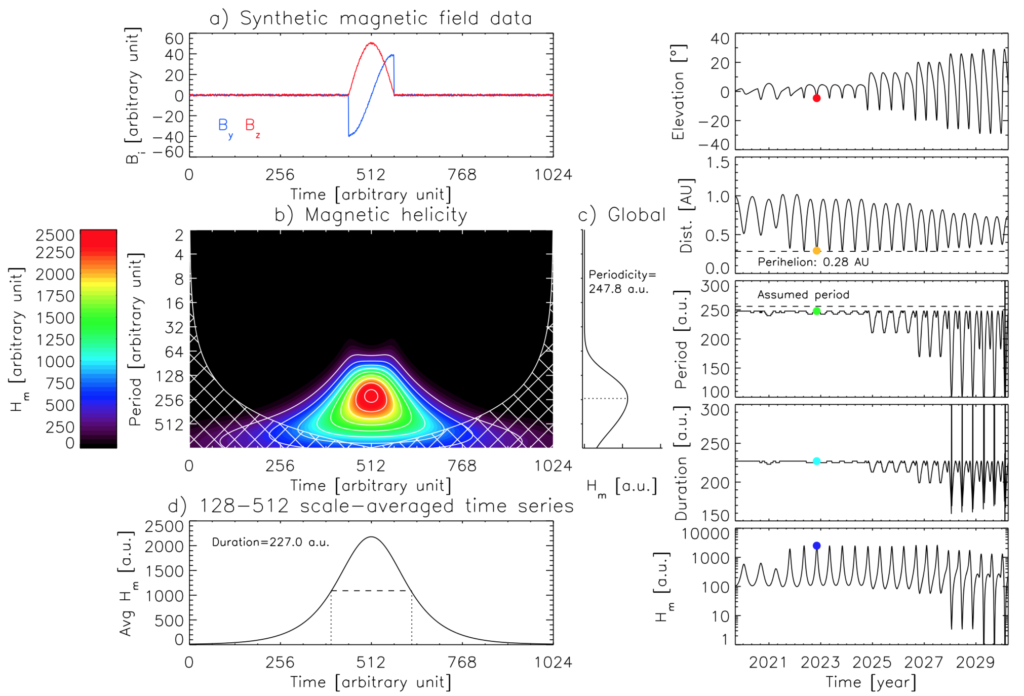
The accuracy of this method to infer flux rope properties depends on the proper evaluation of the direction of propagation of the flux rope itself, which is often difficult to assess. We present a numerical test of the reliability of this diagnostic technique, by simulating a synthetic flux rope of fixed size and propagation direction along the Solar Orbiter orbit, that is very elongated and inclined with respect to the orbital plane. We find that when the flux rope is crossed for less than 50% of its width, the procedure becomes unreliable. Quantitative information on how to properly recover the flux-rope intrinsic properties is provided.
Publication: Telloni D., D’Amicis R., Bruno R., Carbone F., Perrone D., Zank G. P., Zhao L., et al., 2020, ApJL, 899, L25.
https://iopscience.iop.org/article/10.3847/2041-8213/abacc4
Study of the Influence of the Solar Wind Energy on the Geomagnetic Activity for Space Weather Science
Papers from SWICo members
Telloni, Daniele; Carbone, Francesco; Antonucci, Ester; Bruno, Roberto; Grimani, Catia; Villante, Umberto; Giordano, Silvio; Mancuso, Salvatore; Zangrilli, Luca
This paper addresses the investigation of the interaction of the solar wind energy with the Earth’s magnetosphere, by studying its correlation with the disturbance storm time (Dst) index, a proxy of the geomagnetic activity. Some relevant parameters of the solar wind (the bulk speed and the z-component of the interplanetary magnetic field) are explored in the energy-Dst space.
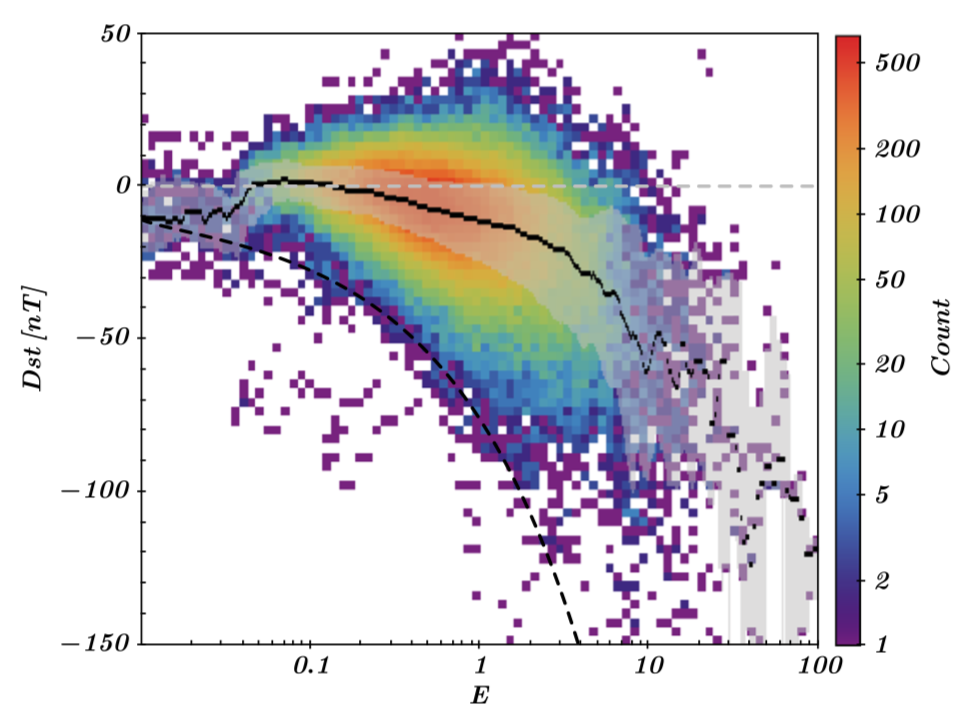
It results that (I) the solar wind energy and the geomagnetic activity are strictly related, with the coronal mass ejections representing the most energetic and geoeffective driver; (II) the slow solar wind has negligible effects on Earth regardless of its energy content, whereas high-speed streams may induce severe geomagnetic storming depending on the advected energy; and (III) while at low and mid energies, geomagnetic disturbances are induced provided the magnetic reconnection between the interplanetary and terrestrial magnetic fields occurs, high-energy solar wind plasma can impact Earth even without reconnecting with the geomagnetic field at the dayside magnetopause. The most significant result in the framework of space weather science resides in the observational evidence that the Earth’s magnetosphere has a maximum response to the energetic content of the solar wind, which leads to the derivation of an empirical law allowing the proper forecast of the upper limit of the intensity of any geomagnetic disturbance on the basis of the solar wind energy derived in situ at the Lagrangian point L1.
Publication: Telloni D., Carbone F., Antonucci E., Bruno R., Grimani C., Villante U., Giordano S., et al., 2020, ApJ, 896, 149.
https://iopscience.iop.org/article/10.3847/1538-4357/ab91b9/pdf
Detection of Coronal Mass Ejections at L1 and Forecast of Their Geoeffectiveness
Papers from SWICo members
Daniele Telloni , Ester Antonucci, Alessandro Bemporad, Tiziano Bianchi, Roberto Bruno, Silvano Fineschi, Enrico Magli, Gianalfredo Nicolini, and Roberto Susino
A novel tool aimed to detect solar coronal mass ejections (CMEs) at the Lagrangian point L1 and to forecast their geoeffectiveness is presented in this paper. This approach is based on the analysis of in situ magnetic field and plasma measurements to compute some important magnetohydrodynamic quantities of the solar wind (the total pressure, the magnetic helicity, and the magnetic and kinetic energy), which are used to identify the CME events, that is their arrival and transit times, and to assess their likelihood for impacting the Earths magnetosphere.
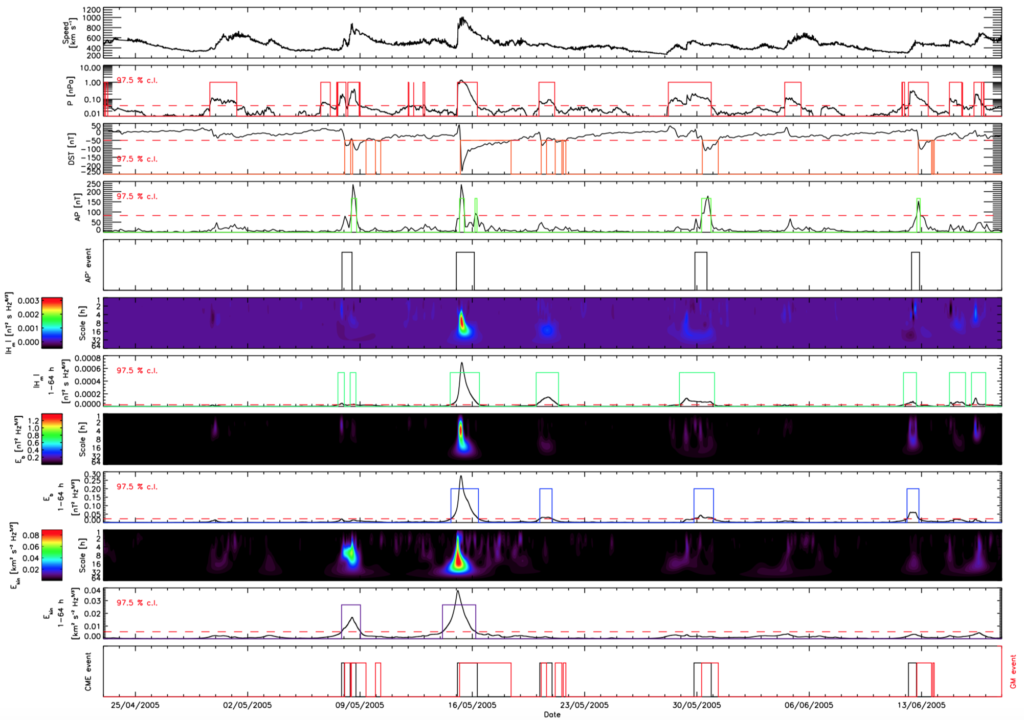
The method is essentially based on the comparison of the topological properties of the CME magnetic field configuration and of the CME energetic budget with those of the quasi-steady ambient solar wind. The algorithm performances are estimated by testing the tool on solar wind data collected in situ by the Wind spacecraft from 2005 to 2016. In the scanned 12 yr time interval, it results that (i) the procedure efficiency is of 86% for the weakest magnetospheric disturbances, increasing with the level of the geomagnetic storming, up to 100% for the most intense geomagnetic events, (ii) zero false positive predictions are produced by the algorithm, and (iii) the mean delay between the potentially geoeffective CME detection and the geomagnetic storm onset if of 4 hr, with a 98% 2-8 hr confidence interval. Hence, this new technique appears to be very promising in forecasting space weather phenomena associated to CMEs.
Publication: Telloni D., Antonucci E., Bemporad A., Bianchi T., Bruno R., Fineschi S., Magli E., et al., 2019, ApJ, 885, 120. doi:10.3847/1538-4357/ab48e9
https://iopscience.iop.org/article/10.3847/1538-4357/ab48e9/pdf
Lower-thermosphere response to solar activity: an empirical-mode-decomposition analysis of GOCE 2009-2012 data
Papers from SWICo members
Alberto Bigazzi, Carlo Cauli, and Francesco Berrilli
The thermosphere is a layer of the high Earth atmosphere which extends into the Low Earth orbit (LEO) region. It is extremely sensitive to the activity of our star, especially to solar radiation in X-rays and ultraviolet. When the sun is at a minimum of activity, as in these years, its X-rays and UV emission is reduced and the thermosphere cools and collapses. On the contrary, when solar activity increases the thermosphere expands and penetrates into circumterrestrial space.
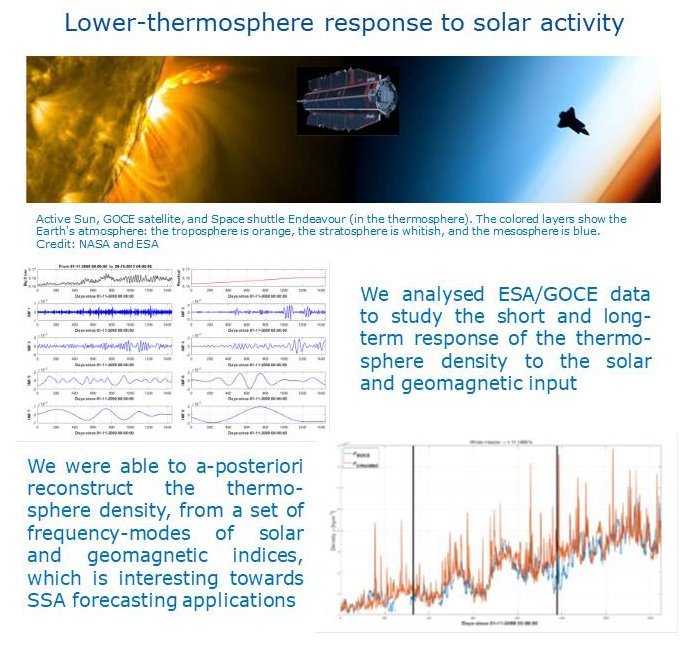
Since about 70% of the current operative satellites are in LEO, the expansion of the thermosphere increases drag on satellites and, changing their orbits, increases the need for orbital maneuvers with effects on orbital station-keeping and satellite life-time. The same effect is present in the case of the space debris (over 70% of the debris are in LEO).
By analyzing more than four years of data from extremely precise accelerometers, capable of measuring small accelerations (1 part out of 10 million of Earth’s gravity acceleration), on board the ESA/GOCE mission we connected the density variations of the thermosphere to the solar and geomagnetic activity. In order to model the density of the thermosphere to the solar and magnetospheric signals, we used the frequency modes that have the greatest impact on the thermosphere’s density.
Publication: Bigazzi A, Cauli C., Berrilli F., 2020, Annales Geophysicae, Volume 38, Issue 3, 2020, pp.789-800, DOI: 10.5194/angeo-38-789-2020 https://angeo.copernicus.org/articles/38/789/2020/angeo-38-789-2020.pdf
Intermittency and Passive Scalar Nature of Electron Density Fluctuations in the High-Latitude Ionosphere at Swarm Altitude
Papers from SWICo members
G. Consolini, P. De Michelis, T. Alberti, I. Coco, F. Giannattasio, R. Tozzi, and V. Carbone
The Sun interaction with the magnetosphere-ionosphere system can induce turbulent fluctuations in magnetic and electric fields and plasma density in the high-latitude ionosphere, particularly during geomagnetically disturbed periods. Here, we focus on the electron density fluctuations as observed by one of the satellites of the ESA Swarm constellation, and we show how such fluctuations are strongly intermittent in nature. Furthermore, we demonstrate that the anomalous scaling features of the electron density fluctuations are those expected for a passive scalar quantity in fluid turbulence.
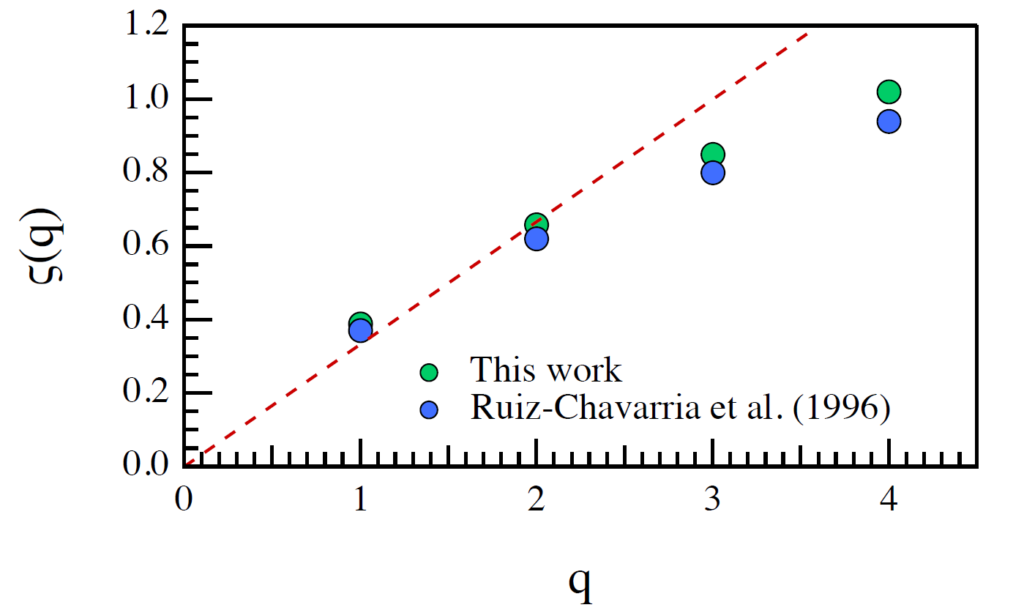
Publication: G. Consolini, P. De Michelis, T. Alberti, I. Coco, F. Giannattasio, R. Tozzi, and V. Carbone, Intermittency and Passive Scalar Nature of Electron Density Fluctuations in the High-Latitude Ionosphere at Swarm Altitude, Geophys. Res. Lett., 2020.
https://doi.org/10.1029/2020GL089628
On the 2015 St. Patrick Storm Turbulent State of the Ionosphere: Hints from the Swarm Mission
Papers from SWICo members
P. De Michelis, A. Pignalberi, G. Consolini, I. Coco, R. Tozzi, M. Pezzopane, F. Giannattasio and G. Balasis
We analysed the electron density fluctuations in the high-latitude ionosphere during the St. Patrick’s geomagnetic storm occurred on 17 March 2015, in order to investigate the possible turbulent nature of the ionospheric plasma. Electron density measurements were taken in both hemispheres from two of the three ESA Swarm satellites (A and B), covering the time period between 16 and 22 March 2015.
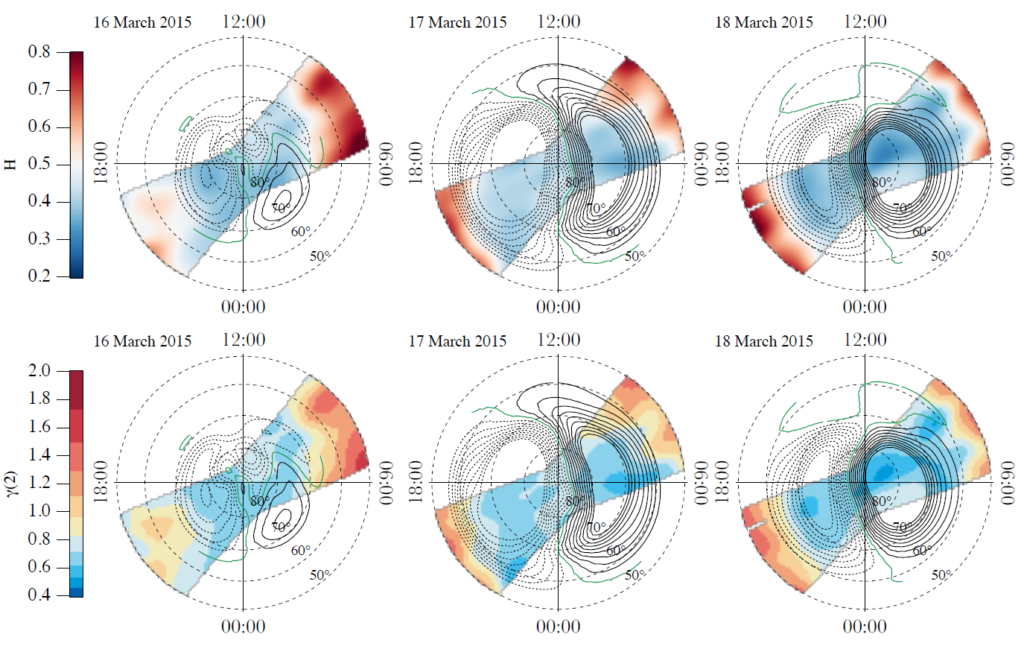
We reconstructed the Rate Of change of electron Density Index (RODI), which can be considered as a proxy for the presence of plasma irregularities, and compared it with quantities related to the spectral properties of the electron density fluctuations. We found that, independently of the different phases of the analyzed geomagnetic storm, the observed fluctuations pattern seems to support the idea of a fluid and/or magnetohydrodynamic turbulence as the main cause of the high values of RODI recorded at high latitudes in the auroral and polar cap regions.
Publication: P. De Michelis, A. Pignalberi, G. Consolini, I. Coco, R. Tozzi, M. Pezzopane, F. Giannattasio and G. Balasis, On the 2015 St. Patrick Storm Turbulent State of the Ionosphere: Hints from the Swarm Mission, J. Geophys. Res.: Space Physics, 125, 2020.
https://doi.org/10.1029/2020JA027934
Linear vs nonlinear methods for detecting magnetospheric and ionospheric current systems patterns
Papers from SWICo members
T. Alberti, F. Giannattasio, P. De Michelis and G. Consolini.
The geomagnetic field time series can be viewed as a superposition of signals which represent the different contributions to it at different scales coming from various sources both internal and external to the Earth. Here, we apply two different methods of analysis in order to recognize in the magnetic field of external origin the different contributions coming from external sources, making use of measurements of the vertical component of the geomagnetic field (directed away from the Earth’s center) recorded by the European Space Agency (ESA) Swarm A and B satellites at low and mid latitudes during a geomagnetically quiet period.
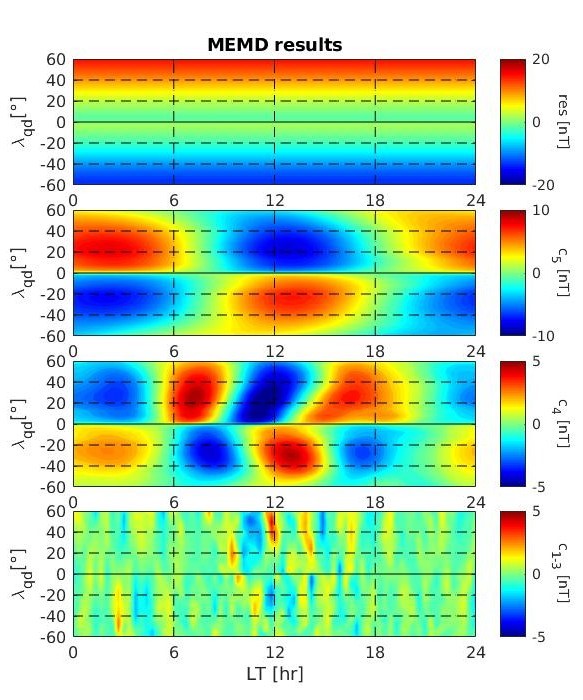
The first is a linear method, that is, the Empirical Orthogonal Functions (EOF); the second is a nonlinear one, i.e. the Multivariate Empirical Mode Decomposition (MEMD). As the external contributions to the magnetic signal are intrinsically nonlinear, the MEMD seems to give better results with respect to EOF, and only five modes and a residue are necessary to reproduce the different contributions coming from the external sources against the 26 modes that are necessary in the case of the EOF. This study is an example of the potential of the MEMD for the analysis of the geomagnetic field of external origin, and of its capability to separate the ionospheric from the magnetospheric contributions in a simple and rapid way.
Publication: T. Alberti, F. Giannattasio, P. De Michelis and G. Consolini, Linear vs nonlinear methods for detecting magnetospheric and ionospheric current systems patterns, Earth and Space Science, 2020.
https://doi.org/10.1029/2019EA000559
On the multifractal features of low-frequency magnetic field fluctuations in the field-aligned current ionospheric polar regions: Swarm observations
Papers from SWICo members
G. Consolini, P. De Michelis, T. Alberti, F. Giannattasio, I. Coco, R. Tozzi, and T. T. S. Chang
In this work we have characterized the magnetic field fluctuations in the high latitude ionosphere by means of high resolution magnetic measurements (50 Hz) from the European Space Agency Earth’s observation mission Swarm.
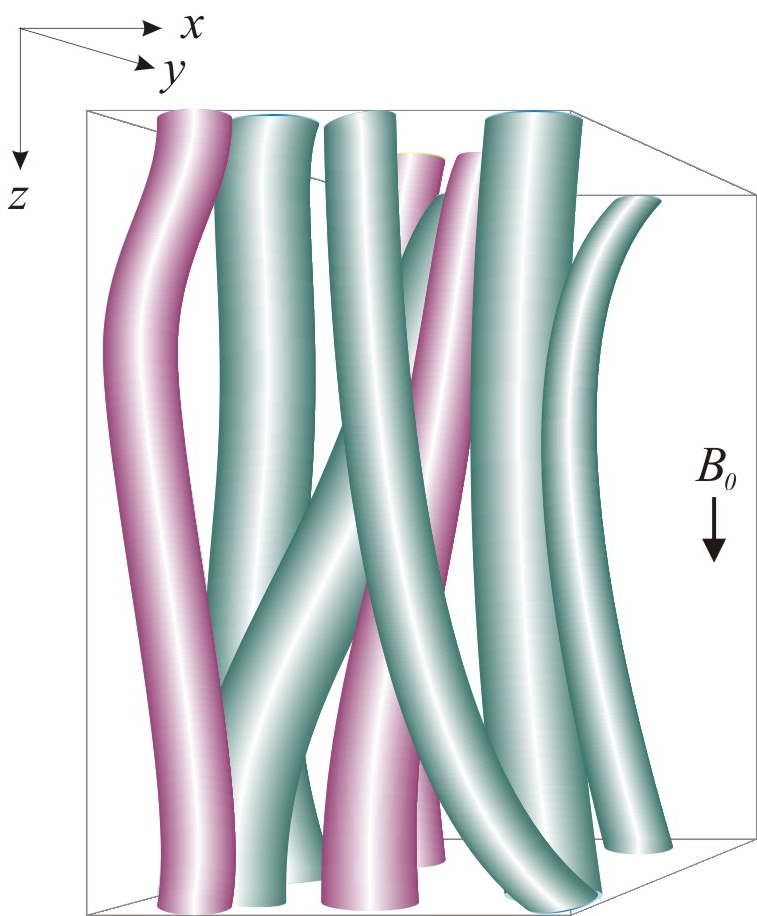
We found anomalous spatiotemporal scaling features of magnetic field fluctuations in regions where field‐aligned currents occur, at spatial scales in the range 0.8–80 km (timescales in the range 0.1–10 s). The nature of these fluctuations is multifractal, suggesting a highly complex structure of the field‐aligned currents. Our results support the hypothesis that field‐aligned currents are filamentary in nature, and this paves the way to new perspectives in the comprehension of the physical processes responsible for the magnetospheric‐ionospheric coupling.
Publication: G. Consolini, P. De Michelis, T. Alberti, F. Giannattasio, I. Coco, R. Tozzi, and T. T. S. Chang, On the multifractal features of low-frequency magnetic field fluctuations in the field-aligned current ionospheric polar regions: Swarm observations, J. Geophys. Res.: Space Physics, 125, 2020.
https://doi.org/10.1029/2019JA027429
Continuum Enhancements, Line Profiles, and Magnetic Field Evolution during Consecutive Flares
Papers from SWICo members
Zuccarello, Francesca; Guglielmino, Salvo L.; Capparelli, Vincenzo; Mathioudakis, Mihalis; Keys, Peter H.; Criscuoli, Serena; Falco, Mariachiara; Murabito, Mariarita
The occurrence of very energetic solar flares can give rise to Space Weather phenomena impacting on the circum-terrestrial environment.It is well known that, during solar flares, magnetic energy can be converted into electromagnetic radiation from radio waves to γ-rays. Enhancements in the continuum at visible wavelengths, as well as continuum enhancements in the FUV and NUV passbands, give rise to the so-called white-light (WL) flares. Moreover, the strong energy release taking place during these events can lead to the rearrangement of the magnetic field at the photospheric level, causing morphological changes in sunspots.

In this paper, we describe the results of the analysis performed using data acquired by satellite instruments (Interface Region Imaging Spectrograph (IRIS), Solar Dynamics Observatory/Helioseismic and Magnetic Imager, Hinode/Solar Optical Telescope) and ground-based telescopes (Rapid Oscillations in the Solar Atmosphere (ROSA)/Dunn Solar Telescope) during two consecutive C7.0 and X1.6 flares (accompanied by an eruption) that occurred in active region NOAA 12205 on 2014 November 7. The analysis shows the presence of continuum enhancements during the evolution of the events, observed both in ROSA images and in IRIS spectra. We also investigate the role played by the evolution of the δ sunspots in the flare triggering, as well as the changes in the penumbrae surrounding these sunspots as a further consequence of these flares.
Publication: Zuccarello F., Guglielmino S. L., Capparelli V., Mathioudakis M., Keys P. H., Criscuoli S., Falco M., et al., 2020, ApJ, 889, 65. doi:10.3847/1538-4357/ab621f
https://iopscience.iop.org/article/10.3847/1538-4357/ab621f/pdf
The ionosphere prediction service prototype for GNSS users
Papers from SWICo members
Sreeja Vadakke Veettil, Claudio Cesaroni, Marcio Aquino, Giorgiana De Franceschi, Francesco Berrili, Filippo Rodriguez, Luca Spogli, Dario Del Moro, Alice Cristaldi, Vincenzo Romano, Roberto Ronchini, Stefano Di Rollo, Eric Guyader, Angela Aragon-Angel
The effect of the Earth’s ionosphere represents the single largest contribution to the Global Navigation Satellite System (GNSS) error budget and harsh ionospheric conditions can impact seriously on GNSS system functionality, including integrity, accuracy and availability. With the growing reliance on GNSS for many modern technological applications, reliable ionospheric forecasts can contribute to the understanding and mitigation of the impact of the ionosphere on our technology based society.
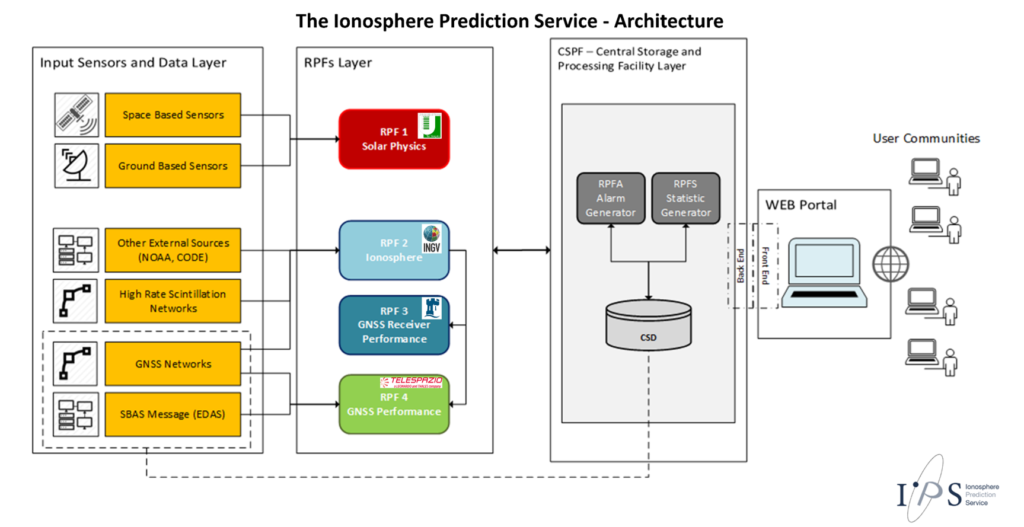
With this aim, the Ionosphere Prediction Service (IPS) project was set up to design and develop a prototype platform to translate the forecast of the ionospheric conditions into a service customized for different GNSS user communities. To achieve this overarching aim, four different product groups dealing with solar activity, ionospheric activity, GNSS receiver performance and service performance have been developed and integrated into a service chain, which is made available through an innovative and fully customizable web based platform. This paper provides an overview of the IPS project describing its overall architecture, products and platform.
Publication: Veettil, S. V., Cesaroni, C., Aquino, M., De Franceschi, G., Berrili, F., Rodriguez, F., … & Ronchini, R. (2019). The ionosphere prediction service prototype for GNSS users. Journal of Space Weather and Space Climate, 9, A41.
https://www.swsc-journal.org/articles/swsc/full_html/2019/01/swsc190019/swsc190019.html
